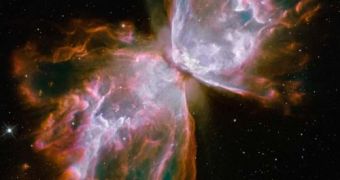During the 13-day STS-125 mission to the Hubble Space Telescope in May, astronauts aboard space shuttle Atlantis conducted a large number of repairs and improvements on the iconic observatory, bringing it once again up to the highest standards. Now, after some five months of tests and calibrations, astronomers are finally able to enjoy new, high-quality images of the Universe, taken with the new Wide Field Camera 3 (WFC3), the most technologically advanced instrument aboard the telescope, Space reports.
The WFC3 is able to snap photographs using two different and complementary light channels. The first of them works in optical wavelengths, dealing in the range between 200 and 1,000 nanometers, while the second works in the near-infrared wavelengths, and is sensitive to the 800 to 1,700-nanometer range. The Advanced Camera for Surveys (ACS) was also repaired during the fifth and final servicing mission to the 19-year-old telescope, and it too was used for some of the new images, which include a “butterfly nebula,” a galaxy cluster, a stellar nursery, and an image of the galaxy NGC 6217.
Senator Barbara A. Mikulski, D-Md, who is the chairwoman of the Commerce, Justice and Science Appropriations Subcommittee, responsible for funding NASA, was the one who unveiled the new images recently. She has been given the honorary title of “Godmother of Hubble,” for the crucial support she gave the aging telescope in Congress, and for fighting to approve the over $1 billion necessary for the STS-125 mission, including money for the rockets, planning, the instruments, and so on. “I fought for the Hubble repair mission because Hubble is the people's telescope,” the Senator said at the event.
“We couldn't be happier about the way things have gone. We're fully confident the camera is working as it was intended to work,” University of Virginia expert Bob O'Connell added. He is the WFC3 science oversight committee chief. The camera was in fact used two months ago, when an object impacted Jupiter, and created a new, Pacific Ocean-sized, black scar on its surface. However, at the time, the instrument was not yet precisely calibrated, so its full observational potential was not used.
The Cosmic Origins Spectrograph is Hubble's new instrument for ultraviolet spectroscopy of faint point sources, in the 115 to 320-nanometer wavelength ranges. During the Atlantis repair mission, it was set in the place once occupied by the defective Corrective Optics Space Telescope Axial Replacement (COSTAR) science instrument. The new spectrograph can snap photos in one-tenth of the time COSTAR used to, which means that scientists can now analyze ten times more targets than before. The plan is now to create a map of as many light sources as possible, as well as a diagram of how matter is distributed through the Universe.

 14 DAY TRIAL //
14 DAY TRIAL //